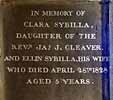For this church:    |
|
Key to Monuments |
Chancel
1. On the north wall of the chancel there is a memorial to the Revd William Saltern by John Flaxman. He was vicar of Cotgrave and died in 1811 when he fell though the ice when skating on the lake at Thoresby. It is surmounted by a carved figure of a seated woman reading. The figure is renaissance in white marble but Flaxman has placed this in a Gothic ashlar frame the combination being quite pleasing.
On the north wall of the chancel there is a memorial to the Revd William Saltern by John Flaxman. He was vicar of Cotgrave and died in 1811 when he fell though the ice when skating on the lake at Thoresby. It is surmounted by a carved figure of a seated woman reading. The figure is renaissance in white marble but Flaxman has placed this in a Gothic ashlar frame the combination being quite pleasing.
SACRED TO THE MEMORY OF |
2.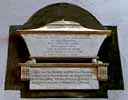 Over the door in the chancel is a memorial to John Shering of Nottingham who died in 1800 and was the son of Samuel Shering, steward to the 2nd Duke of Kingston.
Over the door in the chancel is a memorial to John Shering of Nottingham who died in 1800 and was the son of Samuel Shering, steward to the 2nd Duke of Kingston.
SACRED BE THIS SPOT TO GRATITUDE |
3. The chancel north wall has a memorial to Evelyn Henry Frederick Pierrepont, who died 28 October 1801. Above the inscription is a large carved angel holding a book with an urn above.
The chancel north wall has a memorial to Evelyn Henry Frederick Pierrepont, who died 28 October 1801. Above the inscription is a large carved angel holding a book with an urn above.
SACRED TO THE MEMORY OF THE TRULY HONOURABLE |
4. To the right of the altar there is a memorial to Evelyn Pierrepont, 2nd Duke of Kingston, credited to Michael Wright of York. The memorial was commissioned in 1800.
To the right of the altar there is a memorial to Evelyn Pierrepont, 2nd Duke of Kingston, credited to Michael Wright of York. The memorial was commissioned in 1800.
To the Memory of |
Vestry
5. The north wall of the vestry has a memorial to Sophia Manvers Pierrepont, who died in 1823 aged 32, believed to be by Pierre Bazzanti. It comprises a tablet surmounted by a carving of a recumbent woman with angel over and portrays the Virgin Mary’s ascent to heaven. This pre-dates the organ and was installed when the vestry was treated as a private chapel.
The north wall of the vestry has a memorial to Sophia Manvers Pierrepont, who died in 1823 aged 32, believed to be by Pierre Bazzanti. It comprises a tablet surmounted by a carving of a recumbent woman with angel over and portrays the Virgin Mary’s ascent to heaven. This pre-dates the organ and was installed when the vestry was treated as a private chapel.
IN MEMORY OF |
6.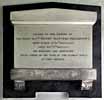 The east wall has a memorial to Sophia’s husband, Henry Manvers Pierrepont, who died in 1860.
The east wall has a memorial to Sophia’s husband, Henry Manvers Pierrepont, who died in 1860.
SACRED TO THE MEMORY OF |
7.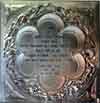 In the corner is a memorial to Charles Evelyn, Viscount Newark, who died in 1850, and his wife, Emily, who died in 1851.
In the corner is a memorial to Charles Evelyn, Viscount Newark, who died in 1850, and his wife, Emily, who died in 1851.
In Memory |
8. Further along the south wall is a stone and slate memorial to Charles, First Earl Manvers, who died in 1816.
Further along the south wall is a stone and slate memorial to Charles, First Earl Manvers, who died in 1816.
SACRED |
South Aisle
9.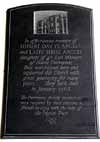 A slate memorial at the east end of the south wall is to Hubert and Lady Sibell Argles who both died in 1968:
A slate memorial at the east end of the south wall is to Hubert and Lady Sibell Argles who both died in 1968:
In affectionate memory of |
10. Below Monument 9 is a slate tablet in memory of Lady Alice Pierrepont who died in 1969 and was buried at Ystrad Mynach church near Caerphilly in South Wales.
Below Monument 9 is a slate tablet in memory of Lady Alice Pierrepont who died in 1969 and was buried at Ystrad Mynach church near Caerphilly in South Wales.
In loving memory of |
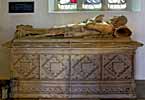 |
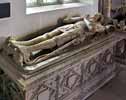 |
 |
 |
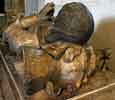 |
 |
 |
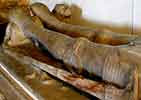 |
The tomb has no inscription but there is no doubt that it is Sir Henry Pierrepont who died in 1499. His will, proved on the 18th December of that year, specified that he should be 'buried in the church and a tomb of alabaster be made and set upon a sepulchre and graven by the discretion of his executors'. The effigy is in the gothic style and form favoured in the period of the Wars of the Roses and the effigy carries the suns and roses collar of the House of York which is odd for the date as this decoration had fallen from favour many years earlier. It is possible that the tomb was carved some years earlier or that Henry’s executors wished to record his support of the Yorkist cause. In any case this is the last monument, still in existence, to display this decoration. The effigy’s head rests on a great helm with a fox passant crest. The source of the alabaster cannot be determined as the effigy has been stained during construction by oils that have given it a pleasant olive hue but in the absence of serious veining is most likely to be Chellaston. The sword at one time has been broken and the replacement, probably done during refurbishment, is in Fauld alabaster. The carver is unknown but the centre of such tomb construction in the late 15th century was Burton on Trent and as there are similarities with other monuments in the area indicating it is most likely to be a product of those workshops.
 |
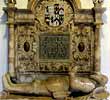 |
 |
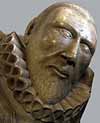 |
 |
Close by is another tomb of alabaster also to a Sir Henry Pierrepont who died on the 19 March 1615. The monument was designed by John Smythson, son of Robert. There is a drawing by Smythson for the design of the tomb in the R.I.B.A. Collections. Sir Henry married Frances Cavendish the daughter of Bess of Hardwick. The monument is an interesting one and this too may have been repositioned.
 Hollar's Hollar's engraving |
In 1676 Wenceslaus Hollar made an engraving (left) of the monument showing the tomb chest on a plinth which is not there today.
The monument comprises a wall mounted mural and an effigy on a tomb chest. The effigy is in Stuart renaissance style but rests on a tomb which displays panels from a completely different era more in keeping with the mid 16th century. The panels are in very poor condition and display figures, probably of the children, holding shields on the tomb chest. The panels may at one time have spent time outside. The chest frame however is contemporary with the date of death and is in Fauld alabaster. The conclusion is that the tomb chest has used parts from an earlier tomb which cannot be identified. It may well have been repositioned omitting the plinth shown in 1676.
The wall mural displays the Dutch style which came to England from the late 16th century. The features show two columns supporting cornice which includes armorial devices associated with the Manvers/Pierrepont family. The back panel displays two ovoids of a black marble-like stone. This is cockleshell 'marble' which is found only in South Yorkshire and North Derbyshire and only used on mural monuments between 1615 and 1626. The term marble is a loose description as Britain has no natural marble and the term is used for varieties of limestone.
It is credited to architect John or Robert Smythson but, although these men were trained as stonemasons, there are no records of any monuments being carved by them. The carver may well be from the Burton on Trent workshops in which case it was carved by the Hollemans but the style is more in keeping with the carvers of London. It could be from the Stone or Jannsen workshops the finished monument being shipped by coastal barque and river boat to Holme and assembled by the Smythsons.
The inscription reads:
HERE LIETH THE BODIE OF SR HENRIE PIERREPONT |
13. A 17th century brass to Gervase Pierrepont is attached to the wall above monument 14. Gervase was the second son of Sir George Pierrepont and his second wife, Winifred (daughter of William Thwaites of Oulton in Suffolk).
A 17th century brass to Gervase Pierrepont is attached to the wall above monument 14. Gervase was the second son of Sir George Pierrepont and his second wife, Winifred (daughter of William Thwaites of Oulton in Suffolk).
The inscription reads:
AMORIS ET GRATITVDINIS ERGO |
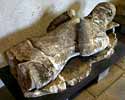 |
 |
An effigy of which only the trunk, head and parts of the great helm (tilting helmet) remain. This is clearly 14th century Chellaston alabaster. It is believed to be Sir Edmund Pierrepont c.1370. The crest on the great helm has been broken of but may well have displayed a dog (or a fox) consistent with the other memorials. The alabaster effigy comprising of just the trunk of a knight wearing a pointed bascinet, camail, a jupon with crenulated edge and sword belt and may well have been demolished to make way for the later monuments. It too is not in its original condition and may have spent some time outside as it shows signs of agricultural implements having been sharpened on it. The effigy was, at one time, full length and is almost certainly the work of the Chellaston workshops then the only ones working in the area.
15.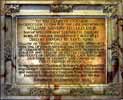 Near the door is a memorial to William Sanday (died 1920), one-time chaplain to Edward VII and George V.
Near the door is a memorial to William Sanday (died 1920), one-time chaplain to Edward VII and George V.
TO THE GLORY OF GOD AND |
 |
 |
The monument is a magnesian limestone recumbent effigy of a civilian about 5ft long and is somewhat weathered indicating that it may one time been outside. Information dates this from the late 13th century and was believed to be Sir Henry Pierrepont c.1290, however, the style is in more in keeping with the mid-14th century. He is dressed as a merchant with curly long hair and long extensions to the sleeves. His head rests on a rectangular cushion supported by two angels and his feet on an animal which may be a dog or a lioness. The animal’s head is turned away from the effigy. The man’s tunic has a belt and a purse. The monument is not identified but is thought not to be of the Pierrepont family. It is not in its original position and may well have once been in the old chancel. This is believed to be the work of a local carver.
17. In the corner is a memorial to the Revd John Cleaver (died 1823), his wife (died 1818) and daughter (died 1828). This is the father of James Jarvis Cleaver (later Peach) mentioned in the incumbent list.
In the corner is a memorial to the Revd John Cleaver (died 1823), his wife (died 1818) and daughter (died 1828). This is the father of James Jarvis Cleaver (later Peach) mentioned in the incumbent list.
IN MEMORY AGED 78 YEARS. ALSO OF ELIZABETH, HIS WIFE, DAUGHTER OF JAMES FENTON ESQRE WHO DIED AT MALTON, IN THE COUNTY OF YORK FEBRUARY 1ST 1818, AGED 67 YEARS. |
IN MEMORY OF |
 |
 |
Affixed to the west wall of the south aisle is a brass of an unknown standing lady dating from 1385 which has been repositioned. It was found in 1960 when alterations to the church floor were carried out.
A fragment of the marginal inscription survives and reads:
Vo Idq a |
19. On the westernmost pillar of the south arcade is a tablet memorial to satirical poet, John Oldham, dated 1683. William, Earl of Kingston, invited Oldham to be his chaplain; although he declined the appointment he accepted the Earl’s hospitality at the Hall. However, on the 9 December 1683 he died there of smallpox aged only 30.
On the westernmost pillar of the south arcade is a tablet memorial to satirical poet, John Oldham, dated 1683. William, Earl of Kingston, invited Oldham to be his chaplain; although he declined the appointment he accepted the Earl’s hospitality at the Hall. However, on the 9 December 1683 he died there of smallpox aged only 30.
The tablet has a surround of carved flowers and leaves with an angels head on the crown and a further carved head on the apron. The inscription is reputed to be written by the Earl but John Dryden also wrote an eulogy and he may well have been the author.
M.S. |
Nave
20.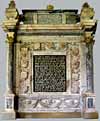 At the west end of the nave there is a later Fauld alabaster mural memorial to Princess Gertrude, Countess of Kingston dated 1649. At the start of the Commonwealth the appearance of effigies on monuments was coming under scrutiny and so it was felt that only simple murals should be made. Therefore this is a plain inscribed tablet with a surround of shields with the base decorated with skulls, cross bones and swags. The tablet has two Corinthian columns which may be stained to resemble marble with decorated entablature over. Over the columns there are single obelisks and a crown tops the entablature. The monument has clearly been repositioned as it sits on modern ashlar corbels and the columns appear to be a composition. The Nottingham Evening Post of 23 October 1878 reported that the monument was moved from the memorial chapel to its present location as part of T C Hine's restoration work.
At the west end of the nave there is a later Fauld alabaster mural memorial to Princess Gertrude, Countess of Kingston dated 1649. At the start of the Commonwealth the appearance of effigies on monuments was coming under scrutiny and so it was felt that only simple murals should be made. Therefore this is a plain inscribed tablet with a surround of shields with the base decorated with skulls, cross bones and swags. The tablet has two Corinthian columns which may be stained to resemble marble with decorated entablature over. Over the columns there are single obelisks and a crown tops the entablature. The monument has clearly been repositioned as it sits on modern ashlar corbels and the columns appear to be a composition. The Nottingham Evening Post of 23 October 1878 reported that the monument was moved from the memorial chapel to its present location as part of T C Hine's restoration work.
The monument may well be by Richard Hall of Nottingham.
Here lyeth the illustrious Princess GARTRUDE, |
21.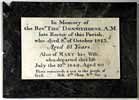 Tablet to the Rev Thomas Donnithorne (died 1813):
Tablet to the Rev Thomas Donnithorne (died 1813):
In Memory of |
22.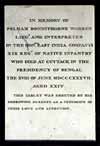 Tablet to Pelham Donnithorne Warren (died 1837):
Tablet to Pelham Donnithorne Warren (died 1837):
IN MEMORY OF |
23. Tablet to John Burgess (died 1842):
Tablet to John Burgess (died 1842):
ERECTED |
24.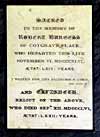 Tablet to Robert Burgess (died 1846) and his wife, Elizabeth (died 1856):
Tablet to Robert Burgess (died 1846) and his wife, Elizabeth (died 1856):
TO THE MEMORY OF |
25.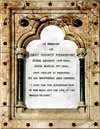 Tablet to Henry Sydney Pierrepont (died 1882):
Tablet to Henry Sydney Pierrepont (died 1882):
IN MEMORY |
Tower
26. Tablet to John Barfoot (died 1824):
Tablet to John Barfoot (died 1824):
IN  When he reflected credit upon |




